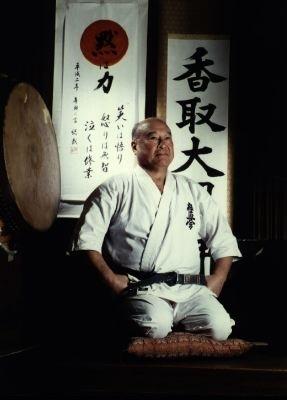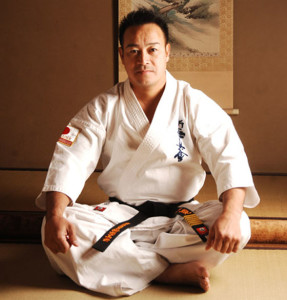History of Kyokushin Karate (Shinkyokushin)
The founder of Karate Kyokushinkai – Sosai Masutatsu Oyama – was born on the 27th of July, 1923, in a village in South Korea. At the age of 9, while staying at his sister’s farm in Mandjuriya, he started training in Chinese Kenpo and more particular “The Eighteen Hands” form. In 1938, Oyama left for Japan with the intention to enroll in an aviation school to become a jet pilot, but he had to give up on his dream. He continued to practice Judo and box, and his interest in martial arts led him to the dojo of Gichin Funakoshi, where he started practicing Okinawa Karate.

Sosai Masutatsu Oyama – Founder of Kyokushin Karate
Oyama advanced quickly due to his great dedication. He was only 20 years old when he achieved the rank of 4th Dan. In the same period of time, Oyama enrolled in the Japanese Imperial Army and started practicing Judo in order to master its hand grip techniques. In four years, he achieved the rank of 4th Dan in Judo and ended up its training.
After the Japanese defeat in Second World War, Oyama, as any young Japanese, relapsed into personal anguish. He managed to find a way out of his despair while training with So Nei Chu, a Korean master in Goju-Ryu Karate. This great teacher famous for the strength of his body as well as for his deep spirituality had a great impact on the young Mas Oyama. Master So taught him the inhesion of BUDO and the spiritual foundations of Buddhism. After some years of traning, Master So advised Mas Oyama to make a vow to dedicate his life to the Warrior’s Way, and to seclude himself into the mountains, to train his mind and body.
In October 1946, Oyama began exercising in isolation in the Minobu Mountain. Only two months later, he was forced to return to civilization due to the lack of supplies.
In September 1947, he won unreservedly the All-Japan Open Karate Championship. However, this for him was not enough, and in 1948 Mas Oyama withdrew into the Kiosumi Mountain, in Chiba prefecture. He was followed by another trainee – Yashiro. The friend/sponsor Mr. Kayama supplied them with food every month. Through vigorous training, Mas Oyama learned to overcome the anxiety caused by the solitude, but Yashiro was unable to do this. After 6 months, he escaped, leaving Oyama alone. Eighteen months later, Mr. Kayma informed Masutatsu Oyama that, due to unexpected circumstances, he could no longer support the food provisions for his isolation in the mountains. As a result, Oyama’s original plan to remain cut off for three years was untimely interrupted.
After returning from his isolation, Oyama won again the All-Japan Open Karate Championship. His success was followed by many victories in different martial championships and tournaments with dissimilar rules and regulations. Many times, he challenged to fight without rules masters from different martial arts, but they all ended up with a clear-cut win by Oyama. In this way, he practiced and perfected his Karate.
Masutatsu Oyama opened his first dojo in 1953 in Meijiro, Tokyo. This was the time when the strength of Mas Oyama was in its highest point, and the trainings in the dojo were ruthless. Many of his apprentices were members of different martial arts, and Oyama compared their styles and forms with his Karate. He adopted the best techniques and concepts and incorporated them in his trainings. In this way, he set up the foundations of Kyokushin Karate. The formation of the world organization began in 1960, and it was officially open in July, 1965. It was named the International Karate Organization (IKO). It was at this time when Oyama introduced the name for his style in karate – Kyokushin (the ultimate truth) – and began spreading it all over the world, creating one of the biggest martial arts organizations on the planet. Because of his contribution to the development of karate, Oyama was awarded the honored title “Sosai”.
Kyokushin Karate proved to be the hardest and most aggressive style in karate. Many of its disciples became champions in fights with different rulings. Kyokushin fighters were noted for their exceptional strength and high fighting spirit. This raised the authority of the style and won its recognition in the martial arts circles.
After the death of Sosai Oyama in April, 1994, some of his apprentices formed their own organizations with the same name. Therefore, after a general meeting of the branch chiefs, it was decided almost unanimously that the name should be changed in order to protect its unique identity. The name of the organization was changed to “World Karate Organization (WKO) – Shinkyokushinkai”. The word “shin” was added to the word “kyokushinkai”. “Shin” in Japanese has two meanings: “truth” and “new”. In this way, the meaning of the word “Shinkyokushinkai” may be translated as “True Kyokushinkai” and “New Kyokushinkai”. “WKO-Kyokushinkai” remained true to the codes of Oyama Sosai who was against the professionalizing and commercializing of the Organization. Its main goals remain, i.e. education of young people and international communication and collaboration. The distinctive sign of the organization became the symbol “Kokoro” (“Heart”, in Japanese), signifying the unity of mind, skills and physica strength. Since 2001, the president of the Organization has been Kenji Midori – world champion from the 5th World Championship (1991), who was also the last champion of the United Kyokushin.

Kenji Midori – President of the World Karate Organization
Today, “WKO – Shinkyokushin” is the biggest world organization in full-contact karate, with 93 country members. Daily and yearly, it becomes more and more popular worldwide. An increasing number of young people practicing it is an indicator of the rightess of the chosen path inherited from the ideas of Sosai.
“WKO – Shinkyokushinkai” works in a firm collaboration with the Japanese Olympic committee for the admission and approval of Karate as an Olympic sport. This is expected to become reality in 2020 when Japan will host the 32nd Summer Olympic Games.
Our sensei, Sensei Sholin, is officially recognized by the World Karate Organization and is currently teaching classes at his dojo in Woodland Hills, CA. All ages and levels are welcome. Click here to go to the class schedule page.
